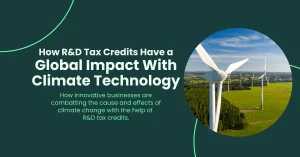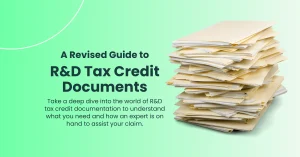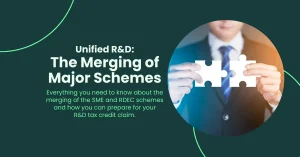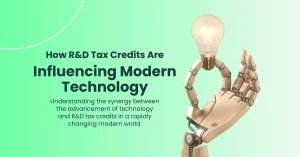Breaking down HMRC’s guidelines for compliance for a successful R&D claim
28 February 2024

R&D legislation is always evolving to prevent fraud and to ensure that the incentive covers all types of costs for innovative businesses carrying out research and development. HMRC has developed an informative resource known as the Guidelines for Compliance (GfC3) to make a successful R&D claim. The purpose of the guidance is to help you avoid common mistakes in claiming R&D tax credits to increase the chances of a successful application. In this article, we will outline the key R&D tax relief guidance to function as your handy guide, helping you to provide HMRC with what they are looking for in your claim, as well as filling in the blanks where confusion sits.
What are HMRC’s latest guidelines for compliance for R&D?
HMRC’s guidelines for compliance were first published in 2021 and have been evolving since then. We see this guidance as an essential resource for R&D claimants. Over the last few years, HMRC has increased their vigilance over fraud and errors in R&D claims, even employing extra inspectors to monitor the compliance levels of R&D tax credit claims. They write in part one: “We want to help you make a correct R&D claim, avoiding the penalty we charge if carelessness leads to an inaccurately high claim.” The guidance they’ve offered aids in reducing the likelihood of an inquiry which is made up of 6 parts that cover:
Part 1: Purpose, scope and background
This details what to expect from the following parts. The guidance summarises best practices for claiming R&D tax credits and provides key information on:
- Understanding what HMRC expects of you as the role of the claimant.
- How to identify who is a ‘competent professional’ in the eyes of HMRC.
- Knowing if your work qualifies as R&D.
- Pinpointing what they mean by ‘scientific or technological advancement’ as this is a central component of the R&D eligibility criteria.
- Detailing the scientific or technological advancement of your project and knowing how it counts as an advancement.
- The importance of identifying exactly when your R&D project began and finished. This requires an understanding of what counts as R&D.
- Knowing what evidence and documentation is required for your R&D claim.
Part 2: Expectations of claimants
This part of the guidance is all about what you need to do before you make the R&D claim. HMRC provides 13 steps that you need to take. Examples include that the competent professional should be responsible for:
- Identifying the R&D projects you’re claiming for (they must have the aim to create an advance past existing knowledge and your competitors’ capabilities).
- Outlining the beginning of each uncertainty and at which point it was solved. If it wasn’t solved in the year you’re claiming, make that clear.
- Describing what the plan was to tackle the uncertainty.
- Validating if the R&D costs align with the eligibility criteria.
Part 3: Importance of a competent professional
A common error that arises in R&D claims is the incorrect identification of the competent professional. You’ll need to consult with this individual for your claim to gain their insights regarding the R&D projects. A competent professional is someone with relevant experience or qualifications in the specific field of the R&D project you’re engaged in. Perhaps they have industry awards, a degree, continuous professional development in the field, or a relevant publication in the field, as examples, and this would make them a competent professional. Having a competent professional involved in your R&D claim serves the purpose of utilising their expertise to identify uncertainty and technological advancement.
Part 4: How to identify qualifying R&D activities
When we discuss an R&D project, what we mean is a series of R&D activities and HMRC provides extensive information on what counts as eligible R&D activities in part 4. Each of these activities works together collectively to reach a goal. A project is a necessity – a common error that keeps arising is when a business has advanced in science and technology, but if it has not been as part of a project then it can’t count for R&D tax credits. If the project just had purely commercial aims as opposed to actually resolving technical or scientific uncertainties, then it doesn’t qualify. It can’t use readily available information either.
Read about the examples of R&D projects. In simple terms, an R&D project may seek an advancement by creating or improving a:
- Process
- Material
- Device
- Product
- Service
Part 5: The recommended approach to R&D claims and record keeping
A lot of documentation goes into each R&D claim and this involves extensive record keeping. The main point HMRC iterates is that if you believe the work you’re doing is eligible R&D then you should plan for your R&D claim by writing as you go along. We recommend you journal your activities, including the failures, because it will strengthen your technical narrative being able to see exactly how you made the technical advancement and the key dates involved. Keep all receipts and invoices to help you create a claim with financial accuracy.
Of course, it is common that you may identify eligible R&D activities after the project has been completed. We often find this with our clients because we reach out to them to check if their innovative project qualifies. This can often make the documentation difficult because you have to cast your mind back to the little details of the project. A competent professional or R&D tax credit specialist such as ourselves can help you determine eligibility when looking back.
More records will be needed if HMRC decides to open a compliance check into your claim. Essentially, they’ll need to see some evidence. This could look like:
- Seeing requesting documents
- Visiting your site
- Examining the completed products or prototypes
- Speaking to your team
Part 6: Further information
In this part of the R&D tax relief guidance, HMRC details what to do if you have made an error in an earlier R&D claim as well as other key pieces of information and key contact details.
How should you use this guidance?
These guidelines for compliance from HMRC are incredibly helpful for all R&D claimants; however, without an in-depth understanding of R&D legislation, there is still scope for error which needs to be avoided in light of HMRC’s crackdown on non-compliance. In other words, it is not a substitute. Professional R&D advice is always recommended to accompany this guidance for your claim.
What are the latest changes to R&D tax credit relief in 2024?
This guidance was almost overshadowed by the changes to R&D tax credits that were announced in the Autumn Statement 2023 and will commence after the 1st of April 2024. Here’s a recap of what they are:
- There are no longer separate R&D tax credit schemes based on the size of your company and expenditure. The 2 schemes have merged into one with the same rate of 20%, seen as an above-the-line benefit.
- The rate for loss-making companies is 25%.
- The R&D expenditure threshold has been reduced to 30%.
- There is a one-year grace period if you don’t meet the 30% intensity threshold.
- Payments will no longer be sent to third parties.
There is still a requirement to notify HMRC if you are claiming for the first time and to fill out an R&D additional information form.
Key takeaways
The recently issued R&D tax relief guidance by HMRC is an information-dense resource that serves as a helping hand for R&D claimants. It focuses on the importance of properly preparing your claim with a correctly chosen competent professional and knowing about what qualifies as an R&D activity. Understanding this guidance enables you to provide HMRC with the exact information they need, speeding up the process of receiving your tax benefits directly and reducing the chance of undergoing a time-consuming (and sometimes costly) compliance check.
How can Alexander Clifford help you?
As R&D tax credit specialists with a long track record of successful R&D claims, our experts understand the intricacies of R&D legislation and use HMRC’s R&D tax relief guidance in our processes for each R&D claim. Whether you’re ready to start your claim or you want to check if you’re eligible, our team is here to help. Get in touch with our team of sector specialists.







